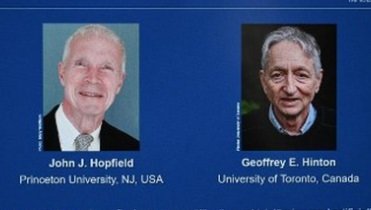In a landmark decision that bridges the worlds of physics and artificial intelligence (AI), the Nobel Prize in Physics 2024 was awarded to John J. Hopfield and Geoffrey E. Hinton. Both have been recognized for their pioneering contributions to machine learning, particularly in the realm of artificial neural networks. Their work laid the foundation for modern AI technologies, which have transformed industries from healthcare to autonomous vehicles.
John J. Hopfield: Associative Memory and the Hopfield Network
John J. Hopfield’s contributions to AI began with his development of the Hopfield network, a model that simulates how memory is stored and recalled in the human brain. Drawing inspiration from the behavior of atomic spins—microscopic physical particles that interact to reach stable states—Hopfield applied similar principles to artificial neural networks.
The Hopfield network operates as a memory system, composed of interconnected nodes that resemble the pixels in an image. These nodes communicate with one another, much like the neurons in our brains. The network is engineered to minimize energy, akin to how atomic spins settle into stable configurations. As the network is trained, it adjusts the strength of its connections, enabling it to store specific patterns as low-energy states. These patterns represent stored memories, and the network becomes adept at recalling them even when presented with incomplete or noisy information.
For instance, if the network is given a blurred or fragmented image, it processes the information by updating the nodes to reduce energy, eventually reconstructing the closest matching image from its memory. This remarkable feature has applications in image recognition and pattern matching, key elements in today’s AI systems.
Geoffrey E. Hinton: The Boltzmann Machine and Statistical Learning
Geoffrey E. Hinton built on Hopfield’s framework by introducing the Boltzmann machine, another neural network model that integrates ideas from statistical physics. While the Hopfield network is adept at recalling specific patterns, the Boltzmann machine excels at recognizing common features and patterns within large datasets. Its strength lies in its ability to learn from complex data and create new examples based on what it has already seen.
The Boltzmann machine works by examining numerous examples of data and learning to recognize patterns and features over time. It can classify data, identify hidden structures, and even generate new data that shares similarities with the original dataset. This innovation became a crucial tool in advancing machine learning, enabling AI systems to handle vast amounts of information and perform complex tasks, such as language processing and image classification.
Impact on AI and Physics
The revolutionary work of Hopfield and Hinton has not only transformed the field of AI but also made significant contributions to physics. Their models of neural networks have become instrumental in various applications, such as pattern recognition, where they are used to identify faces, objects, and even medical anomalies in images. These networks also facilitate data analysis, allowing scientists to decipher patterns in enormous datasets.
In physics, their models assist researchers in discovering new materials with unique properties. The crossover between AI and physics demonstrates the versatility and far-reaching impact of Hopfield and Hinton’s work, influencing both technological advancements and scientific research.
Background of the Laureates
- John J. Hopfield, born in 1933 in Chicago, USA, completed his Ph.D. at Cornell University in 1958. He is a professor at Princeton University, where his interdisciplinary work has influenced both physics and biology.
- Geoffrey E. Hinton, born in 1947 in London, UK, earned his Ph.D. from The University of Edinburgh in 1978. He is a professor at The University of Toronto and has made monumental contributions to the development of deep learning, a key component of modern AI.
A Lasting Legacy
Hopfield and Hinton’s achievements have laid the foundation for many of the AI-driven innovations we see today. Their neural network models have opened doors to new possibilities in technology, healthcare, and science, and their impact will continue to resonate for generations to come. As AI becomes increasingly integrated into daily life, the work of these two laureates will remain central to the field’s progress.
Their 2024 Nobel Prize in Physics stands as a testament to the transformative power of interdisciplinary research, celebrating the intersection of physics and AI that is shaping the future.


